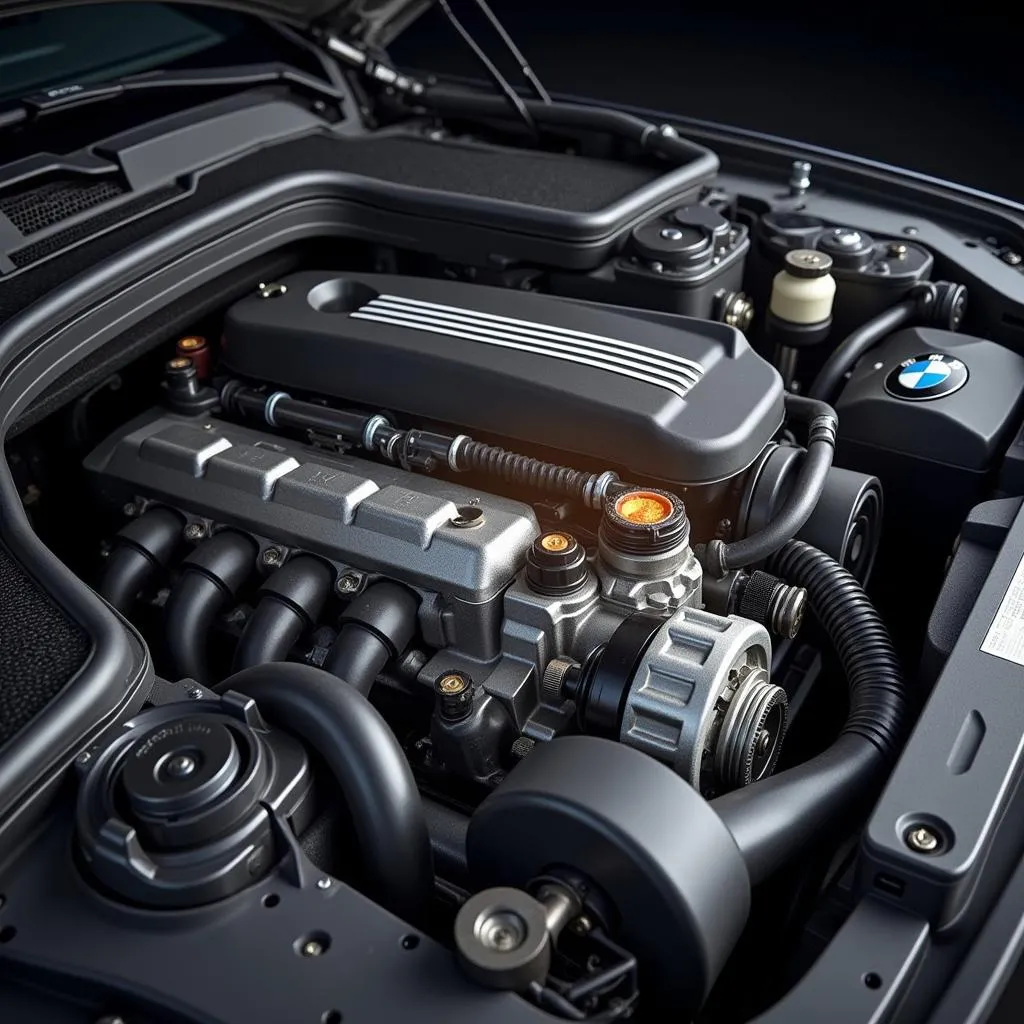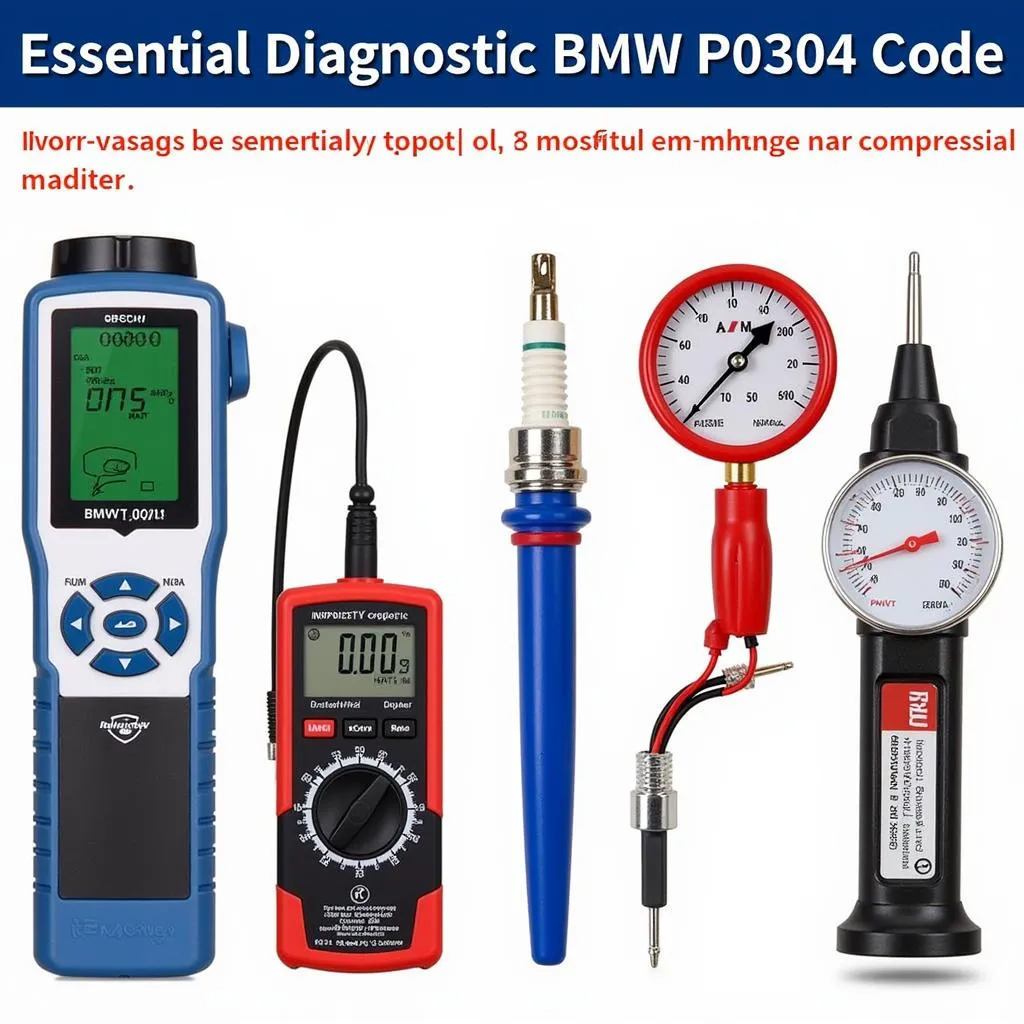BMW P0304 Code: Deciphering the Misfire Mystery
The dreaded check engine light illuminating your BMW dashboard can be a cause for concern. If it’s accompanied by a P0304 code, you’re dealing with a cylinder 4 misfire – a common issue that can impact your car’s performance and fuel economy. Understanding the P0304 code and its potential causes is the first step towards a smooth, powerful ride.
What Does the P0304 Code Mean?
The P0304 code specifically indicates that your BMW’s engine control unit (ECU) has detected a misfire in cylinder 4. A misfire occurs when the air-fuel mixture in the cylinder fails to ignite properly, leading to a loss of power and increased emissions.
 BMW Engine Cylinder Misfire
BMW Engine Cylinder Misfire
Why is My BMW Showing a P0304 Code?
Several culprits can cause a cylinder 4 misfire in your BMW, ranging from simple spark plug issues to more complex fuel system problems. Here are some of the most common reasons:
- Faulty Spark Plugs and Ignition Coils: Worn-out spark plugs can struggle to create the spark needed for ignition, while failing ignition coils can disrupt the electrical current required to fire the spark plugs.
- Fuel Delivery Issues: Clogged fuel injectors, a malfunctioning fuel pump, or a restricted fuel filter can starve cylinder 4 of the fuel it needs to combust properly.
- Vacuum Leaks: A leak in the intake manifold or vacuum lines can disrupt the air-fuel mixture, leading to a misfire.
- Compression Problems: Worn piston rings, damaged valves, or a blown head gasket can result in low compression in cylinder 4, preventing complete combustion.
- Sensor Malfunctions: Faulty oxygen sensors or mass airflow sensors can provide incorrect data to the ECU, affecting fuel delivery and ignition timing.
Diagnosing a P0304 Code in Your BMW
Pinpointing the root cause of a P0304 code requires a systematic approach. Here’s a step-by-step guide to help you diagnose the issue:
- Check for Visual Clues: Inspect the spark plugs and ignition coils in cylinder 4 for signs of wear, damage, or corrosion.
- Swap Components: Swap the spark plug and ignition coil from cylinder 4 with a known good cylinder. If the misfire moves to the other cylinder, you’ve identified the faulty component.
- Inspect Fuel System: Check for fuel leaks, clogged injectors, or a restricted fuel filter.
- Test for Vacuum Leaks: Use a vacuum gauge or a smoke test to detect any leaks in the intake manifold or vacuum lines.
- Perform a Compression Test: A compression test can determine if cylinder 4 has low compression, indicating a more serious internal engine problem.
 BMW P0304 Diagnostic Tools
BMW P0304 Diagnostic Tools
What Happens If You Ignore a P0304 Code?
Ignoring a P0304 code can lead to further engine damage and more expensive repairs. A persistent misfire can damage the catalytic converter, overheat the engine, and even cause catastrophic engine failure.
“Addressing a P0304 code promptly is crucial,” says John Miller, a certified BMW technician with over 20 years of experience. “Ignoring it can lead to a domino effect of problems, turning a relatively minor issue into a major headache.”
Fixing a P0304 Code
Once you’ve diagnosed the cause of the P0304 code, it’s time to fix it. Here are some common repairs:
- Replace Spark Plugs and Ignition Coils: This is often the simplest and most cost-effective solution for a P0304 code.
- Clean or Replace Fuel Injectors: Clogged injectors can be cleaned, but severely damaged ones may need replacement.
- Repair Vacuum Leaks: Repair or replace any leaking vacuum lines or gaskets.
- Address Compression Problems: Low compression may require a more involved repair, such as replacing piston rings or valve job.
Preventing Future P0304 Codes
You can take proactive steps to prevent future P0304 codes and keep your BMW running smoothly:
- Regular Maintenance: Follow your BMW’s recommended maintenance schedule, including spark plug and air filter replacements.
- Use High-Quality Fuel: Using premium fuel can help prevent fuel system issues.
- Address Engine Issues Promptly: Don’t ignore warning signs like rough idling or decreased fuel economy.
Conclusion
A P0304 code in your BMW can be a frustrating experience, but with a little knowledge and troubleshooting, you can get your car back on the road. By understanding the potential causes and following the diagnostic steps outlined above, you can accurately diagnose the issue and implement the necessary repairs. Remember, addressing the problem promptly can save you time, money, and potential headaches down the road.
FAQs
Q: Can I drive my BMW with a P0304 code?
A: While you can drive short distances with a P0304 code, it’s not recommended. Prolonged driving with a misfire can damage your engine and catalytic converter.
Q: How much does it cost to fix a P0304 code in a BMW?
A: The cost of repair can vary depending on the underlying cause. Simple fixes like spark plug replacement can be relatively inexpensive, while more complex repairs like engine work can be costly.
Q: How can I prevent a P0304 code in the future?
A: Regular maintenance, using high-quality fuel, and addressing engine issues promptly can help prevent P0304 codes.
Q: Can a bad oxygen sensor cause a P0304 code?
A: Yes, a faulty oxygen sensor can provide incorrect data to the ECU, affecting fuel delivery and ignition timing, leading to a misfire.
Q: What other codes are associated with a P0304 code?
A: Other codes, such as P0301, P0302, and P0303, indicate misfires in other cylinders.
For further assistance with your BMW and its P0304 code, feel free to reach out to our expert team. We are available 24/7 to answer your questions and provide personalized guidance. Contact us via WhatsApp: +1(641)206-8880, Email: [email protected] or visit us at 276 Reock St, City of Orange, NJ 07050, United States.
We also have other helpful articles on our website that may provide additional insights into BMW diagnostics and repairs. Check out our bmw p0304 page for a comprehensive guide to this specific code.
